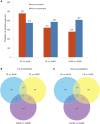Unraveling the Root Proteome Changes and Its Relationship to Molecular Mechanism Underlying Salt Stress Response in Radish (Raphanus sativus L.)
- PMID: 28769938
- PMCID: PMC5509946
- DOI: 10.3389/fpls.2017.01192
Unraveling the Root Proteome Changes and Its Relationship to Molecular Mechanism Underlying Salt Stress Response in Radish (Raphanus sativus L.)
Abstract
To understand the molecular mechanism underlying salt stress response in radish, iTRAQ-based proteomic analysis was conducted to investigate the differences in protein species abundance under different salt treatments. In total, 851, 706, and 685 differential abundance protein species (DAPS) were identified between CK vs. Na100, CK vs. Na200, and Na100 vs. Na200, respectively. Functional annotation analysis revealed that salt stress elicited complex proteomic alterations in radish roots involved in carbohydrate and energy metabolism, protein metabolism, signal transduction, transcription regulation, stress and defense and transport. Additionally, the expression levels of nine genes encoding DAPS were further verified using RT-qPCR. The integrative analysis of transcriptomic and proteomic data in conjunction with miRNAs was further performed to strengthen the understanding of radish response to salinity. The genes responsible for signal transduction, ROS scavenging and transport activities as well as several key miRNAs including miR171, miR395, and miR398 played crucial roles in salt stress response in radish. Based on these findings, a schematic genetic regulatory network of salt stress response was proposed. This study provided valuable insights into the molecular mechanism underlying salt stress response in radish roots and would facilitate developing effective strategies toward genetically engineered salt-tolerant radish and other root vegetable crops.
Keywords: association analysis; iTRAQ; proteomics; radish; salt stress.
Figures








Similar articles
-
Identification of novel and salt-responsive miRNAs to explore miRNA-mediated regulatory network of salt stress response in radish (Raphanus sativus L.).BMC Genomics. 2015 Mar 17;16(1):197. doi: 10.1186/s12864-015-1416-5. BMC Genomics. 2015. PMID: 25888374 Free PMC article.
-
Differential proteomic analysis reveals sequential heat stress-responsive regulatory network in radish (Raphanus sativus L.) taproot.Planta. 2018 May;247(5):1109-1122. doi: 10.1007/s00425-018-2846-5. Epub 2018 Jan 24. Planta. 2018. PMID: 29368016
-
Dissecting Root Proteome Changes Reveals New Insight into Cadmium Stress Response in Radish (Raphanus sativus L.).Plant Cell Physiol. 2017 Nov 1;58(11):1901-1913. doi: 10.1093/pcp/pcx131. Plant Cell Physiol. 2017. PMID: 29016946
-
Transcriptome-based gene expression profiling identifies differentially expressed genes critical for salt stress response in radish (Raphanus sativus L.).Plant Cell Rep. 2016 Feb;35(2):329-46. doi: 10.1007/s00299-015-1887-5. Epub 2015 Oct 30. Plant Cell Rep. 2016. PMID: 26518430
-
Functional and Integrative Analysis of the Proteomic Profile of Radish Root under Pb Exposure.Front Plant Sci. 2016 Dec 15;7:1871. doi: 10.3389/fpls.2016.01871. eCollection 2016. Front Plant Sci. 2016. PMID: 28018404 Free PMC article.
Cited by
-
Advances in Understanding the Physiological and Molecular Responses of Sugar Beet to Salt Stress.Front Plant Sci. 2019 Nov 6;10:1431. doi: 10.3389/fpls.2019.01431. eCollection 2019. Front Plant Sci. 2019. PMID: 31781145 Free PMC article. Review.
-
The photo-inhibition of camphor leaves (Cinnamomum camphora L.) by NaCl stress based on physiological, chloroplast structure and comparative proteomic analysis.PeerJ. 2020 Aug 7;8:e9443. doi: 10.7717/peerj.9443. eCollection 2020. PeerJ. 2020. PMID: 32974090 Free PMC article.
-
Genome-Wide Identification and Functional Characterization of the Cation Proton Antiporter (CPA) Family Related to Salt Stress Response in Radish (Raphanus sativus L.).Int J Mol Sci. 2020 Nov 4;21(21):8262. doi: 10.3390/ijms21218262. Int J Mol Sci. 2020. PMID: 33158201 Free PMC article.
-
Comparative proteomic analysis provides insight into a complex regulatory network of taproot formation in radish (Raphanus sativus L.).Hortic Res. 2018 Oct 1;5:51. doi: 10.1038/s41438-018-0057-7. eCollection 2018. Hortic Res. 2018. PMID: 30302255 Free PMC article.
-
Comparative Proteomic Analysis Provides New Insights Into Low Nitrogen-Promoted Primary Root Growth in Hexaploid Wheat.Front Plant Sci. 2019 Feb 20;10:151. doi: 10.3389/fpls.2019.00151. eCollection 2019. Front Plant Sci. 2019. PMID: 30842781 Free PMC article.
References
LinkOut - more resources
Full Text Sources
Other Literature Sources
Research Materials

